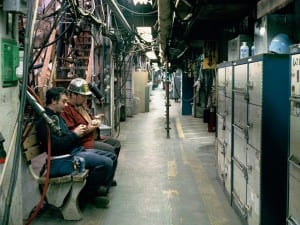Child’s Play brings together an exhibition of photographs, a symposium and a book by artist Mark Neville, who works at the intersection of art and documentary. Kathleen Palmer, Curator: Exhibitions & Displays at the Foundling Museum, London, explains the social function of photography, alongside the global and social significance of recreation.
A: Where did the idea for this exhibition come from, and why do you think that childhood play is such an important topic – both psychologically and socially?
KP: Mark Neville’s ongoing exploration of the social function of photography, and his emphasis on practical social outcomes for his subjects were a natural fit for the Foundling Museum. Artists of all disciplines have worked with and supported the Foundling Hospital throughout its history, and collaboration with artists committed to social change remains at the centre of our practice.
Play offers significant benefits for children’s physical and mental health, and is acknowledged in the 1989 United Nations Convention on the Rights of the Child as a fundamental right. In the face of austerity physical space and time for children’s play is being squeezed, but this could be at the cost of creating a generation of adults with poor health. At a time when up to 13 million children have been internally displaced as a result of armed conflict, and traditional public space is being privatised, Child’s Play reinforces our responsibility to ensure that children the world over have full opportunity for play and recreation.
A: How has Mark Neville responded to the issue?
KP: Neville’s response encompasses the exhibition of his photographs, a book created for targeted dissemination, and the Space to Play symposium. All have a single aim: to improve conditions for children to play. The exhibition presents a series of photographs of children at play in diverse environments around the world. It includes photographs taken in communities from Port Glasgow to North London, and in the war zones of Afghanistan and Ukraine. New images of internally displaced children in Ukraine; residents of Kakuma, Kenya’s second largest refugee camp; and depictions of children at play in London adventure playgrounds, were made especially for this project.
Neville’s book presents images from the exhibition alongside an overview of ground-breaking work in the field of children’s play, to raise awareness of its importance and to focus attention on how conditions for children in the UK can be improved. In order to directly impact upon government and public thinking, Neville has sent out 700 copies of this book for free to town planners, parliamentarians, play workers, opinion formers, key policy makers, quangos, think tanks, other experts in the field and to each of the 433 local councils in the UK. The recent symposium successfully brought together experts and practitioners from a wide range of perspectives including architecture and urban design, play organisations and providers, and psychologists to exchange ideas and develop shared strategies for action and advocacy.
A: How do you think the exhibition raises awareness of important global issues and debate around universal rights?
KP: The project as a whole aims to raise awareness, and prompt action to advocate and promote play provision for children in the UK in particular. However the exhibition takes a global perspective on the subject and the significance of play as a universal right for children recognised by the United Nations. Neville considered very carefully the inclusion of photographs of children taken in the context of war and displacement in Afghanistan, Ukraine and Kenya, in an exhibition centred on children’s rights to play in the UK. He concluded that these images are important; in some way they recalibrate the meaning and significance of play. They reveal a universal drive to play even in the most challenging of circumstances, and the contribution that play can make to children’s ability to cope with and recover from trauma.
A: Why do you think that the show is particularly relevant now due to displaced populations and armed conflict?
KP: This is a time of change and uncertainty, with significant shifts in geopolitics such as Brexit and the new political direction of the United States under Donald Trump. However there is also sadly continuity in the conflicts in Syria, Iraq, Northern Africa and Ukraine which are creating refugees and internal displacement on a huge scale. Children are particularly vulnerable in these circumstances, and the inclusion of photographs reflecting on these global issues in the exhibition highlights their impact on children and reflects on work to shelter and support them.
A: How do you think that the photographs – based around various different environments around the world – will break down barriers and prejudices?
KP: The photographs capture children’s universal need for play across different times and places. The age old game of trundling a hoop, familiar from the Victorian era and earlier in Britain, appears in photographs from Kakuma refugee camp, Kenya and from Helmand, Afghanistan. Neville’s moving image work, Sack Race, 2007 showing scenes from a Port Glasgow School, is juxtaposed with archival footage showing the Foundling Hospital Sports Day in 1899. These commonalities underline a sense of shared humanity, and create space for empathy.
A: How do you respond to the notion that the photographs draw a line between documentary and artwork? Do you think that the images are in any way problematic due to their content?
KP: There is a continuing dialogue around the relationship between documentary and art in lens-based media. Neville brings an important and distinctive voice to this conversation, with an exploration into the possibilities of photography, and in particular portraiture, in giving agency to his subjects and offering positive social outcomes. In creating these arresting and strong images of children involved in the serious business of play, Neville asserts their presence in the world and powerfully advocates for their rights.
Child’s Play runs until 30 April at The Foundling Museum, London. For more information: www.foundlingmuseum.org.uk
Credits:
1. Mark Neville, The Jungle BookRehearsals, Sewickley Academy (2012). Courtesy Mark Neville.





